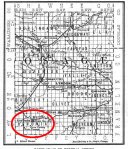Professor D. A. Ellsworth abstracted the history of Chase County from the Chase County Leader News, a collection of unbound newspapers rescued from a garage. Ellsworth’s notes are preserved online by the Chase County Historical Society.
The reports are personal: a marriage, a birth, an arrest, a settler arriving, an untimely death. The reports are interesting: in 1860, the swarm of grasshoppers that arrived, the buffalo that crossed the prairie, gunfights, Texas Longhorns passing through, the injury of Dr. Lacy at the Falls, “while drying gun powder in the stove,” a disappearance or two. The news is national: the Civil War, the death of Abraham Lincoln, elections.
January 7, 1860
Included in the “news” on this day is Ann Yeager’s debut as the first teacher in Bazaar, Kansas. The school is No. 7 in Chase County. Nine years later, on Valentine’s Day, 1869, the Leader reports the marriage of Ann Yeager and Lucius Manley.
Three months earlier, Ann left Indiana and the Wabash River, to accompany her brother George to Bazaar. George had visited Kansas in 1858 and likely was returning as the Osage Indian Lands had been opened to settlement. He farmed along Rock Creek a mile or so west of Bazaar on land that once belonged to the Kaw Indians, for which he would have paid $1.25 an acre. Yeagher Creek flows on the north side of his property.
Grace Hays Blackburn, who grew up in Chase County when the Indians were still there, recalled the first schoolhouse, but whether she or her two brothers, Charley and Dick Hays, went or not we don’t know:
“[The first schoolhouse] was constructed of log slabs, the rough bark on the outside with the smooth sides forming the inside walls. Slabs were used also for benches with wooden pegs for legs.”

The log building would be replaced by a stone building in 1871, and that by the schoolhouse that now stands beside the highway.
Prairie Press, originally from Chase County Historical Sketches, Vol. II, published by the Chase County Historical Society in 1948.
1859
Two months earlier, the paper reported a fierce cold wind and snow. Gold Seekers at Pike’s Peak were returning home. The county board of supervisors ordered the construction of roads. In the June elections for the Wyandotte Convention, the Kansas Press reported that the Bazaar Township should cast 40 votes. The November elections were solidly Republican. On May 30th, The Kansas Press, Volume I, Number 1, was printed at Cottonwood Falls, Samuel N. Wood, editor. His home and his hay crop would be burned that fall.
In the national news, John Brown was arrested at Harpers Ferry.
In February of 1859, Chase County was organized.
What about Ann Yeager
George Yeagher’s life is well documented. He married a girl on a nearby farm, raised a family, lived to the ripe old age of 81. But what of his sister Ann? How long she taught, how many children she had, what became of Ann Yeager is not known. Did she marry and move to nearby Matfield Green or Cottonwood Falls?
Sources
Find a Grave George W. Yeager













